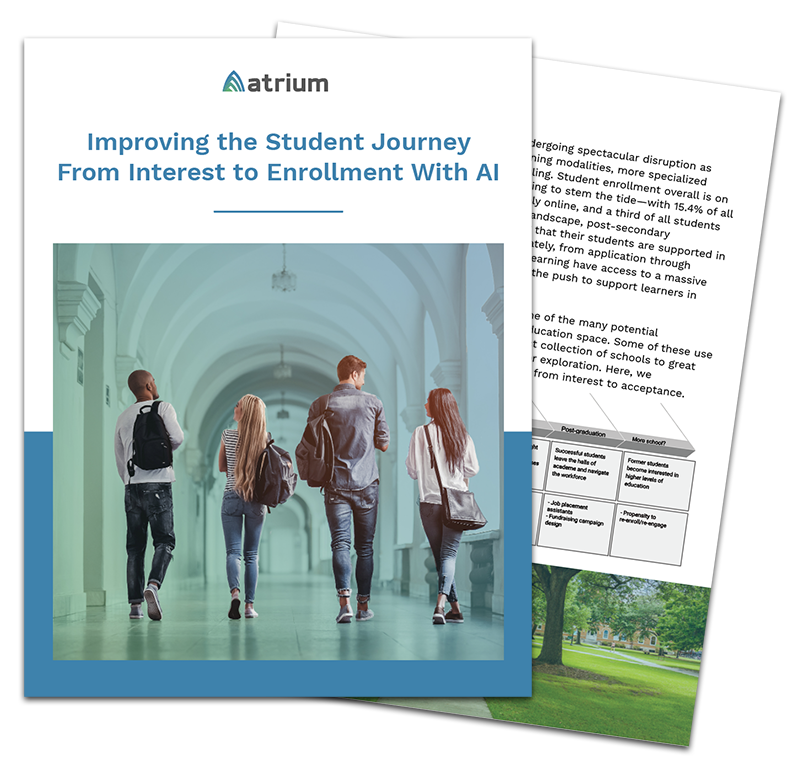It can often feel that everything in higher education is becoming more expensive. From increasing investment in student opportunities and offerings (academic and extracurricular) to staffing reasonable class sizes, to covering shortfalls in external research funding, any source of cost savings through innovation must maintain quality education without breaking the bank. One oft-ignored cost in the student journey is the so-called “acquisition cost.” The focus on acquisition cost is not on the investment it takes to bring one student onboard, but rather how much it will cost to identify and foster the interested students through the process in a timely manner.
The educational landscape is also more diverse for prospective students these days. The most selective schools have an acceptance rate of just 5%, while others have acceptance rates closer to 85%. Clearly, the challenges facing schools will differ along that spectrum: highly selective schools require process flows for redirecting ineligible students quickly, while those at the other end may need to be more proactive in recruiting and guiding leads to success. No matter the perspective, an intelligent experience can bring about efficiencies in this part of the life cycle.
Streamlining the Interest-to-Application Process
Two umbrella use cases for augmented intelligence sit nicely in this period of the student journey: intelligent lead management and degree matching. In the past, these notions have been largely driven by human intuition, and not by data.
Personalize the Lead Experience with Intelligent Lead Management
At Atrium, we’ve analyzed lead data for one institution that suggested some notable trends. These types of insights were then used to craft an individualized lead experience for the students on their path in a way that one-size-fits-all logic cannot.
For example, in this particular group, we found that adult students sprinted through the student enrollment process (perhaps already fully aware of what they want) while students coming directly from high school took much more time to apply. Students interested in technical degrees responded more positively to electronic communications (while liberal studies preferred phone calls). By modeling out these behaviors into experiences or “themes,” we can now create unique student enrollment pathways, such as “Self-Service” for the non-traditional student, “Personalization” for the undergrad and liberal studies prospect, and an “Automation” track for our technical learner.
Degree Matching: Help Students Find Their Preferred Track
Aside from lead management, schools also owe it to their prospective students to help them find a track in which they can succeed. According to the National Student Clearinghouse Research Center, 31 million students left college without a degree, many after only a single term. Furthermore, a bachelor’s degree translates to an average 46% bump in income relative to those whose college progress was incomplete.
Why does this happen? Of course, student support during the term is crucial. But the US Department of Education found that 30% of undergraduates changed their major within the first three years of student enrollment. It stands to reason that some of these students who leave early simply made it into a course of study that didn’t suit them. Routing students to degrees that more closely match their skill set, background, and interests can have a major impact. Machine learning models such as learner clustering, user-user similarly-based recommenders, or multivariate success models for multiple tracks can be deployed to aid student enrollment advisors as they guide prospective learners to their eventual plan of study.
Enable an Intelligent Experience for Attracting and Enrolling Students with Atrium
As the higher education landscape becomes increasingly competitive and diverse, universities need to have an approach that prioritizes intelligent student acquisition and enrollment. We can help you streamline the student experience and create more cost-effective, optimized processes for your staff with the use of AI in the right way, at the right time.
This is just the beginning.
Learn more about leveraging AI to streamline student acquisition costs and improve the student enrollment experience by downloading our whitepaper Improving the Student Journey From Interest to Enrollment With AI.









